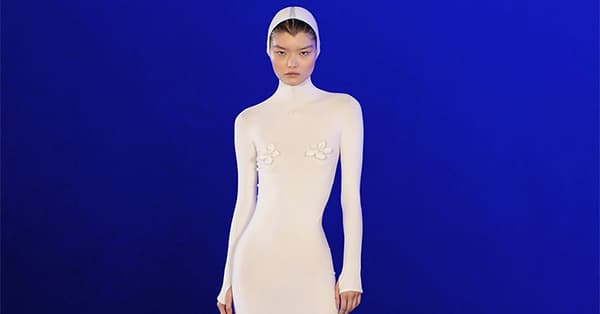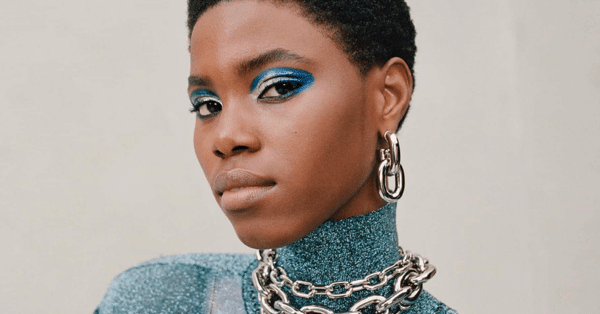Inspired by the ballet ‘Giselle’, the Majorcan designer turns the myth of fatal love into a visual story where fragility and beauty coexist. An intimate exploration of desire, loss, and vulnerability.

In ‘Limerencia, a love written for mourning’, Ingrid Sala Tur transforms romantic tragedy into a visual language charged with emotion. Inspired by ‘Giselle’, the collection delves into the intensity of obsessive love and its passage between purity and ruin. Torn lace, deconstructed corsets and fragmented silhouettes become metaphors for a broken femininity that still inhabits both body and memory. The proposal, awarded Best Collection at ESDi’s Degree Fashion Show, combines conceptual sensitivity and aesthetic precision. Here, fatal love becomes matter, skin, and emotion, a narrative about the beauty that lives within what is broken.
Your project takes ballet Giselle as a starting point. What drew you to that story as a foundation for a contemporary collection?
I’ve always been fascinated by ‘Giselle’ and the way it transforms love into something both beautiful and devastating. I’ve danced since I was a child, and every time I watched the ballet I was completely mesmerized by its delicacy and its tragedy. In its story I found the essence of fatal love —that which transcends reason and becomes madness, pain, and absolute surrender.
I wanted to create a project that truly reflected my own essence and sensibility, and ‘Giselle’ offered me the perfect starting point. I was moved by the fragility of its protagonist, her purity faced with betrayal, and that duality between love and destruction that still exists in today’s relationships.
That’s how ‘Limerencia: a love written for mourning’ was born, a collection that speaks of obsessive love, of desire turned into loss, and of the beauty that lives within pain. A visual narrative about the impossibility of eternal love and the mark it leaves when it fades away.

In Limerencia you talk about “fatal love,” passion, and emotional destruction. How does that transition translate into the garments?
In ‘Limerencia’ I wanted to portray fatal love as a process of transformation, something that leaves deep marks on those who experience it. That transformation is directly reflected in the garments. I wasn’t interested in showing a perfect bride, but one in transformation, fragile, affected by a love story that never fulfilled itself.
That’s why fabrics like tulle, lace, and gauze appear unfinished, frayed, with irregular cuts and deconstructed structures. I was drawn to the idea that beauty doesn’t lie in perfection, but in the crack, in the pain, in what breaks. The color palette —dominated by whites, ivories, and creams— reinforces that feeling of something that once was pure, but no longer is.
As the collection evolves, inspired by ‘Giselle’’s emotional arc, the garments also change. The light tones turn into deep blues until they reach black, reflecting how love becomes tainted and fatal, filled with pain. This metamorphosis symbolizes the passage from innocence to mourning, from the illusion of first love to the emptiness left by betrayal.
Lingerie plays a central role because it represents what is most intimate, closest to the body. Corsets, bras, and garters work as metaphors for vulnerability, they can hold, but they can also constrain, leaving a mark. In that duality, I find an honest way to talk about love, the one that hurts, that leaves scars, but remains profoundly human.

The collection is structured in three chapters —illusion, jealousy, and lament. How did you imagine that narrative journey within the design?
The collection unfolds through three emotional chapters: Conception, Jealousy, and Lament. I wanted the design to function as a visual narration of love, from its birth to its disintegration.
The first chapter, Conception, represents the birth of love, a space of purity, illusion, and surrender. It’s a hopeful, positive moment, yet already contains the seed of tragedy. The silhouettes here are ethereal, subtle, marked by the lightness of fabrics and the fragility of gesture.
In Jealousy, love becomes distorted. It transforms into obsession, control, and fear of loss. Structures tighten, volumes fragment, fabrics darken or tear. The first signs of emotional conflict begin to appear.
In the final chapter, Lament, the collection dives into loss, mourning, madness, and death. The body decomposes, garments fray, light tones fade into darker and deeper shades. The bride no longer waits, no longer loves, no longer remembers; only the void remains, the echo of what was, the scar that persists.
This emotional tragedy isn’t the end, but rather the culmination of an eternal cycle of pain that condemns fatal love to perpetual disintegration. Through materials, cuts, and structures, the collection conveys the passage between desire and pain, between love and loss, between the dressed body and the wounded one.


The figure of the bride is central to your work. What does the broken bride —that disintegrating femininity— symbolize for you?
The figure of the broken bride is the core of ‘Limerencia’. For me, she symbolizes feminine vulnerability and the loss of romantic innocence. She is a woman pierced by love and its consequences, one who has given everything and now faces the emptiness left by betrayal.
Traditionally, the bride represents purity, promise, and perfection. Here, she falls apart. She carries the marks of an unfulfilled story, of a love that never materialized. That disintegration isn’t weakness, but a way of showing what remains when the ideal collapses, when what was once a promise becomes absence.
She embodies the duality that fascinates me: beauty and pain, surrender and loss, the pure and the broken. The broken bride doesn’t seek redemption; she exists suspended between what was and what is no longer. She reflects how love can both construct and destroy us, and how, even in its ruin, something profoundly beautiful persists.


Torn lace, deconstructed corsets and fragmented silhouettes evoke a fragile kind of beauty. What role does vulnerability play in your work?
Vulnerability is the starting point of all my work. I’m interested in what happens when emotion becomes visible, when beauty emerges precisely from what breaks. I’ve always felt that fragility carries a truth that needs no embellishment.
Torn lace, deconstructed corsets and fragmented silhouettes are a way to speak about that, how the body, love, or memory leave their marks. Sewing becomes an extension of emotion, it holds, sustains, but can also open or give way.
I’m not interested in portraying strength in the classical sense, but in showing a figure who allows herself to feel, to be exposed, to fall apart. There’s something deeply human in that vulnerability. I believe that’s where true beauty resides, in that delicate tension between softness and pain.

You cite Zygmunt Bauman and his theory of “liquid love.” How does his sociological vision connect with your poetic and emotional reading of love?
Zygmunt Bauman’s theory of liquid love helped me understand how love is lived today. He speaks of fragile, fleeting relationships that dissolve as quickly as they form. That sociological view felt powerful to me because it mirrors how contemporary love has lost its sense of permanence, it’s no longer built to last, but to be consumed.
In ‘Limerencia’, that idea dialogues with a more poetic and emotional approach. I’m interested in how that social fragility becomes an intimate experience. While Bauman analyzes it from a critical distance, I translate it into emotion, into matter, into skin.
The garments speak of that instability: they unravel, they shift, they tear, just like liquid relationships. But unlike the sociological gaze, my approach lingers on what remains, on the traces that love leaves even when it’s gone. ‘Limerencia’ is, in a way, a resistance to that ephemerality, a way to transform what’s fleeting into something eternal, even through pain.

The title ‘Limerencia’ refers to that obsessive state of infatuation. What is your connection to that idea? Is there a personal story behind it?
The term limerence defines that obsessive state of infatuation, when love becomes a trance, a need, an emotional dependency. I was drawn to it because it perfectly captures that line between the pure and the destructive, between desire and suffering.
More than a specific personal story, ‘Limerencia’ was born from an emotion I know closely, that intensity we all experience when we love without measure. It doesn’t come from a concrete experience but from that universal feeling that consumes us when love becomes so intense it hurts, yet makes us feel more alive than ever.
For me, ‘Limerencia’ doesn’t seek answers. It seeks to relive that vertigo love leaves behind when it turns into a wound, to inhabit the emotion without trying to understand it, allowing beauty and pain to coexist in the same space.

The images convey a romantic and dark atmosphere, almost dreamlike. What did you want to express visually with photographer Andrés Bustamante?
With Andrés Bustamante, we wanted to create a dark, ethereal, melancholic atmosphere, a space suspended between reality and dream. The images don’t aim to tell a literal story, but to capture an emotional state: the fragility after love, the sense of absence, of loss, of pain.
We worked with soft, enveloping light, almost ghostly, to enhance that feeling of time standing still. We wanted the figures to float between presence and absence, as if they were memories lingering in the air.
Visually, I was interested in having the broken bride inhabit that precise moment when beauty begins to decay. Between what was love and what is now memory. Veils, lace and worn textures become witnesses of time, of an emotion that fades but never disappears.
Andrés understood that universe with immense sensitivity. Every image breathes the same melancholy that runs through ‘Limerencia’: a gaze upon love as it turns into darkness, when the wound becomes beauty and loss turns into memory.

You’ve described the project as a reflection on how we continue to romanticize tragedy in love. Do you think fashion can help question those narratives?
Yes, I believe fashion has the power to challenge those narratives because it speaks directly through emotion and the body. In ‘Limerencia’ I wanted to show exactly that: how we keep romanticizing suffering, how we often mistake love for pain, surrender for self-erasure.
I didn’t want to idealize tragedy, but to expose it, to turn it into an image that allows us to look at it differently, to recognize its beauty but also its wound. Fashion, in that sense, becomes a mirror where love reveals its most fragile and human side.
For me, ‘Limerencia’ doesn’t celebrate the tragedy of love, it confronts it. It speaks of our fascination with the fatal, and how even in heartbreak we keep seeking something that makes us feel. In the end, fashion can speak on its own: an image, a gesture, a detail can express everything that words sometimes cannot.
Now that Limerencia has been recognized with the Best Collection award at the ESDi Degree Fashion Show, how do you envision your evolution as a designer?
Receiving the award was very special because ‘Limerencia’ is such a personal project, born from emotion and vulnerability. I see it as a starting point, one that reaffirmed my desire to keep working from that place where fashion meets intimacy, emotion, and art.
From here, I’d like to keep exploring that kind of visual storytelling, where each garment carries a feeling, a fragment of a story. I think my evolution as a designer will go in that direction: creating from truth, from what moves and inspires me.
Thanks to the award, I’ve also had the opportunity to join a Master’s in Styling, which excites me because it will allow me to develop another facet within the fashion world. I’ve always been interested in fashion as a complete language, where design and styling converse and complement each other.
I’d love to hold both perspectives, that of someone who creates a garment, and that of someone who builds a visual narrative through it. Above all, I feel deeply grateful for all the support and trust I’ve received throughout this process. ‘Limerencia’ was a project born from the heart, and having it recognized encourages me to keep creating with the same sensitivity and devotion.

–
Follow us on TikTok @veinmagazine















